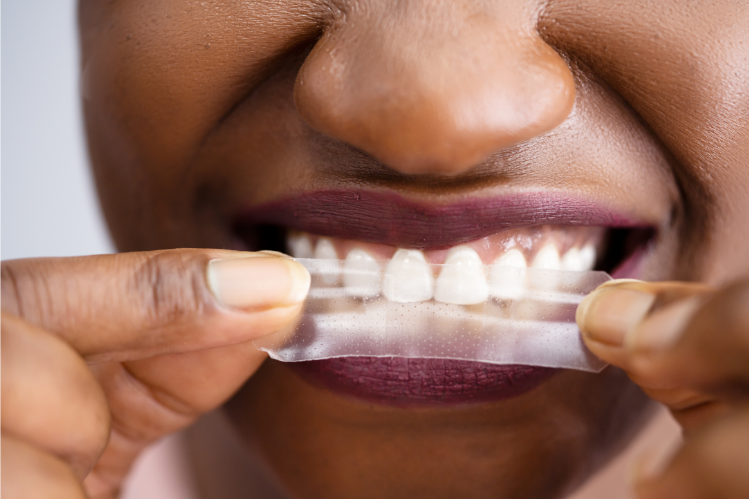
If you’ve ever looked in the mirror and thought your smile could be a little brighter, you’ve probably thought about trying whitening strips. They’re everywhere, in drugstores, online, and even in subscription boxes, and they all promise quick, easy results without going to the dentist. But before you peel off that first strip, there’s this one big question people always ask, which is, are teeth whitening strips safe? Let’s break it down in really simple words, so you know what’s actually true, what’s just a myth, and how to make sure your teeth stay white and your enamel stays healthy.
What’s Enamel and Why Does It Matter?
Enamel is the thin, hard outer layer of your teeth - it’s what protects the softer, more sensitive parts underneath. Once it’s gone, it doesn’t grow back. That’s why any whitening product you use needs to be gentle enough not to harm it, but still strong enough to actually work.
How Whitening Strips Work
Most whitening strips use a peroxide-based gel (usually hydrogen peroxide or carbamide peroxide) to lift surface stains. The strip holds the gel against your teeth for a set amount of time, usually 15–45 minutes. This is long enough for the whitening ingredient to break down stains from coffee, tea, wine, or just everyday wear and tear.
When used correctly, enamel-safe whitening products are designed to brighten your teeth without physically scraping or thinning the enamel. The problem comes when people overuse them or buy low-quality strips with harsh, unregulated formulas.
Do Whitening Strips Damage Enamel?
Short answer: Not if they’re used as directed and from a reputable brand.
Longer answer: Overusing whitening strips - or using strips with a super high concentration of peroxide - can lead to tooth sensitivity and irritation of the gums. While peroxide doesn’t technically “eat away” enamel, excessive use can temporarily weaken it, making teeth feel rough or more porous for a short time. That’s why dentist-approved whitening strips are best - they’re formulated to balance effectiveness with enamel protection.
Signs You’re Overdoing It
If you’re using whitening strips and notice:
- Sharp, zinging pain in your teeth when eating or drinking hot/cold foods
- White spots on your teeth that weren’t there before
- Sore or irritated gums
…you might be whitening too often or leaving the strips on for too long.

How to Protect Enamel during Whitening
To keep your enamel safe while using whitening strips, try these tips:
- Follow the instructions exactly- no extra time “just to make them work faster.”
- Space out treatments- don’t use strips every day for weeks unless it’s part of the brand’s safe protocol.
- Use fluoride toothpaste to strengthen enamel in between whitening sessions.
- Take breaks if you notice sensitivity; enamel can recover, but only if you give it time.
Safest Teeth Whitening Methods at Home
If you want to brighten your smile while protecting your enamel, here are some dentist-approved approaches:
- Use whitening strips from reputable brands with ADA (American Dental Association) approval or dentist recommendations.
- Opt for lower-peroxide formulas if you have sensitive teeth.
- Whitening toothpaste for slow but steady results without the intensity of strips.
- In-office whitening if you want professional oversight and faster results.
The Bottom Line
So, are teeth whitening strips safe? Yes, when they’re used correctly, in moderation, and from trustworthy brands, they can be an effective and enamel-safe whitening method. Also, remember, white teeth aren’t worth sacrificing the health of your enamel, so protect it with good habits, proper use, and regular dental checkups. Do you want the safest and fastest way to whiten without damaging enamel? Ask your dentist which peroxide-based whitening strip safety guidelines they recommend; it could save you from unnecessary sensitivity.
FAQs
Not if you use them as directed. Most dentist-approved whitening strips have safe levels of peroxide and won’t harm healthy enamel, but overusing them can make teeth more sensitive.
To avoid damaging your enamel, make sure to follow the instructions on the box.
It is also important not to use them frequently and not leave them on for more than the
recommended time.
Pro tip: Use them in combination with fluoride toothpaste afterwards, as it will help keep your
enamel strong.
Citations:
Yetman, Daniel. “Do Teeth Whitening Strips Work?” Healthline, Healthline Media, 4 Feb. 2021, www.healthline.com/health/do-whitening-strips-work.







 Australia
Australia New Zealand
New Zealand Malaysia
Malaysia English
English Portuguese
Portuguese English
English English
English English
English English
English English
English Canada
Canada